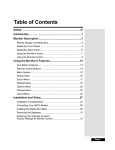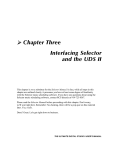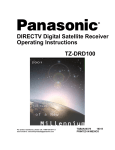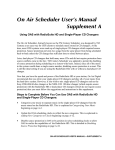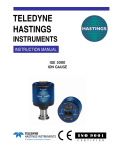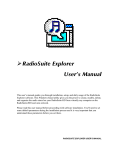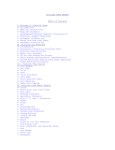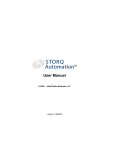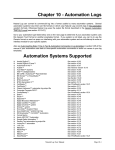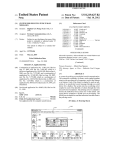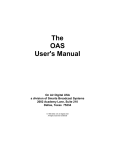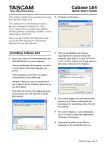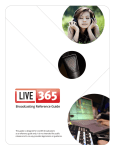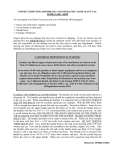Download UDS II and Satellite Programming
Transcript
The
Ultimate Digital
Studio II
and
Satellite
Programming
On Air Digital USA, a division of On Air Worldwide Media, Inc.
13370 Branch View Lane, Suite 120
Dallas, Texas 75234
© 1998 On Air Worldwide Media, Incorporated
All rights reserved.
UDS and The Ultimate Digital Studio are registered trademarks of On Air.
DCS and the Digital Commercial System are registered trademarks of Computer Concepts, Inc.
THE ULTIMATE DIGITAL STUDIO II AND SATELLITE PROGRAMMING
1
Overview
This supplement outlines the procedures necessary to prepare UDS II for the playback of
programming delivered by satellite.
This supplement assumes that the user has some familiarity with UDS II breaknote syntax (as
explained in Chapter Three of The Ultimate Digital Studio II User’s Manual), and how these
breaknotes are included in the music-scheduling software used to generate schedules for UDS II.
If the user has not already done so, he or she should read “The Breaknote Language” in Chapter
Three of The Ultimate Digital Studio II User’s Manual before continuing.
This supplement uses the terms “satellite” and “network” interchangeably to describe
programming delivered by a satellite programming provider.
Basic Requirements
To successfully integrate satellite programming with UDS II, you must have the following:
! UDS II with A4000 audio controller, with one free input to be used as the satellite
programming input.
! Computer Concepts DCS digital audio hard drive storage.
! A satellite receiver capable of generating contact closures for use with automation systems (if
you are using a satellite-delivered programming service with “floating” format clocks with no
precise time for commercial breaks).
Satellite Format Basics–a Sample Format
Most satellite-delivered programs consist of the following elements:
! Core programming material
! Mandatory and optional commercial breaks, to be filled by the affiliate
! Localized voice elements (also referred to as “liners” or “MagiCalls”), started at unscheduled
times by the satellite receiver
To allow affiliates to automate the playback of satellite-delivered programming, most satellite
providers offer switching equipment which decodes information from the satellite receiver. This
information is interpreted by the switching equipment to provide contact closures (sometimes
referred to as cues, pulses, or signals) which can be used to control automation equipment.
Before software configuration or hardware installation can occur, it is necessary to analyze the
format of the satellite-delivered programming, identifying the contact closures needed for liner
playback and return from commercial breaks.
THE ULTIMATE DIGITAL STUDIO II USER’S MANUAL
2
TECHNICAL ADDENDUM
Satellite Format Basics–a Sample Format, continued
Figure 1 illustrates a typical satellite-delivered programming format. The circled numbers refer to
the six contact closures available from the satellite receiver (referred to as “cues” by this satellite
provider), showing locations where these contact closures occur during the hour.
BACKSELL LINER $
AT UNSCHEDULED
POINTS IN HOUR
Cue assignments:
"
Top of the hour sync, fires at exactly 0:00
#
Legal ID, fires at exactly 59:53 (7-second window)
$
Backsell liner–can be fired at any time in the hour
%
Starts optional or mandatory break
&
Return liner–follows option song or ends local break
'
Image liner
Figure 1: Example satellite format clock
ON AIR DIGITAL USA, A DIVISION OF ON AIR WORLDWIDE MEDIA, DALLAS, TEXAS
THE ULTIMATE DIGITAL STUDIO II AND SATELLITE PROGRAMMING
3
Satellite Format Basics–a Sample Format, continued
A systematic analysis of the format clock shows the following:
At exactly 59:53 each hour, the satellite receiver fires a pulse on closure number two, to play the
station legal ID.
At exactly the top of each hour (00:00), the satellite receiver fires a pulse on closure number one,
to provide a method of clock synchronization. The affiliate has the option of inserting a threeminute newscast at the top of the hour or airing music from the satellite provider.
At exactly 00:03, the satellite receiver fires a pulse on closure number four. This closure can be
used by the affiliate to insert additional local programming, if desired. If the affiliate does not
wish to insert local programming, he or she may elect to continue carrying programming from the
satellite network.
At exactly 00:06, contact closure five occurs, playing a return liner, used to provide local
identification when either returning from a break or an optional song.
At approximately 15, 30, and 45 minutes past the hour, contact closure six is fired, to play a
station liner during the segue of two songs.
At approximately 23, 34, and 50 minutes past the hour, contact closure four is fired, to allow
affiliates to play local commercials. At the end of each three-minute window, contact closure five
is fired, to play a return liner, returning to satellite programming.
At random times throughout the hour, contact closure three is fired, to play a localized backsell
liner.
( Please note that this is a sample clock only, and is not representative of all satellite formats.
Please consult your affiliate manual for exact information regarding your satellite format.
THE ULTIMATE DIGITAL STUDIO II USER’S MANUAL
4
TECHNICAL ADDENDUM
Satellite Format Basics–a Sample Format, continued
From the preceding analysis, the following summary can be made:
! Contact closure one from the satellite receiver is used hourly for clock synchronization.
! Contact closure two from the satellite receiver is used to step away from satellite
programming and fire the legal ID.
! Contact closure three from the satellite receiver is fired at random times to play backsell
liners.
! Contact closure four from the satellite receiver is fired to step away from satellite
programming and play local commercial content.
! Contact closure five from the satellite receiver is fired when returning to satellite
programming from local commercials to play a return liner.
! Contact closure six from the satellite receiver is fired near each quarter hour (except the top
of the hour) to play an image liner during a music sweep.
In general, the contact closures described previously can be grouped into three categories:
1. Contact closures used to switch away from satellite programming to locally-originated
programming, such as station identification, commercial breaks and local news (closures two
and four in the previous example).
2. Contact closures used to play unscheduled events without switching away from satellite
programming. These include pre-recorded localization material such as backsell, return and
image liners (closures three, five, and six in the previous example).
3. One contact closure for time clock synchronization that occurs at the top of each hour
(contact closure one in the previous example).
ON AIR DIGITAL USA, A DIVISION OF ON AIR WORLDWIDE MEDIA, DALLAS, TEXAS
THE ULTIMATE DIGITAL STUDIO II AND SATELLITE PROGRAMMING
5
Available Connections to UDS II
UDS II provides full connectivity to satellite receivers to allow automation of satellite
programming. An overview of connections to UDS II follows, with a more detailed description
of satellite connections beginning on page 6.
Figure 2 on page 7 illustrates how UDS II can be connected to a satellite receiver, based on the
sample format on page 2. A complete list of connections to the UDS II RS-422 card 25-pin DSUB connector and the A4000 audio controller audio input connector can be found on pages 21
and 22, respectively.
Audio connections: Audio outputs from the satellite receiver must be connected to the 25-pin DSUB connector on the A4000 input card used as the UDS II satellite source (See Figure 2 on
page 7).
Pin 1: Left + input
Pin 2: Left – input
Pin 3: Right + input
Pin 4: Right – input
Pins 14 through 20, inclusive: audio ground
Satellite end-of-message (EOM) connection: Most satellite providers furnish a momentary
closure (either an open-collector closure or a dry-contact relay closure) to signal the beginning of
commercial breaks. This closure should be connected to the A4000 audio controller input
connector to be used as the UDS II satellite source.
The A4000 audio controller EOM input is a standard TTL ground-switched closure, and is only
active when the A4000 audio channel program input is ON. See Figure 2 on page 7.
Pin 13: End-of-message input
Pin 25: Digital ground
Note: Do not use the audio ground (pins 14-20 on the A4000 audio controller input connector)
for contact-closure returns. Audio and digital grounds are maintained separately in the A4000
audio controller for optimum signal-to-noise performance.
THE ULTIMATE DIGITAL STUDIO II USER’S MANUAL
6
TECHNICAL ADDENDUM
Available Connections to UDS II, continued
Satellite liner connections: Closures for satellite liner playback are connected to the UDS II
RS-422 card 25-pin D-SUB connector. The UDS II external control inputs are standard TTL,
ground-switched inputs. Closures for satellite liners should be either dry contact closures or
open-collector switches capable of switching standard TTL loads.
Satellite Liner Safety Interlock: If desired, a safety interlock can be provided, preventing liners
from playing when the satellite channel is not on-the-air. This is accomplished by connecting the
ground return from the satellite liner closures to the start relay on the A4000 audio controller
input connector for the satellite network source (pin 12). A wire from pin 11 on the audio
controller input connector is then routed to pin 25 (digital ground) of the UDS II RS-422 card
connector, on the rear of the UDS II computer.
UDS II computer time clock synchronization: a contact closure is available to synchronize the
UDS II computer clock to an external time standard. This closure appears on pins 6 (UDS II time
clock sync input) and 25 (digital ground) of the UDS II RS-422 card.
Satellite Receiver Connections to UDS II
The contact closures from the sample satellite format must be connected to UDS II as follows. A
sample interconnection diagram is provided in Figure 2 on page 7.
! Contact closure 1 from the satellite receiver is used to synchronize the clock in the UDS II
computer to the satellite network. This contact closure is routed to the UDS II RS-422 card,
pins 6 (time clock sync input) and 25 (digital ground).
! Contact closure 2 from the satellite receiver is used to play the legal ID during satellite
programming. This closure is routed to the A4000 audio controller end-of-message input for
the satellite program channel pins 13 (end-of-message input) and 25 (digital ground).
! Contact closure 3 from the satellite receiver is used to start backsell liners without switching
away from the satellite network. This closure is routed to the UDS II RS-422 card, pins 7
(external hot key one) and 25 (digital ground).
! Contact closure 4 from the satellite receiver is used to signal UDS II to switch away from the
satellite network and play local commercial breaks. This closure must be routed to the A4000
audio controller end-of message input for the satellite program channel (pins 13 and 25).
! Contact closure 5 from the satellite receiver is used to play return liners when returning from
stop sets or optional fill songs, without switching away from the satellite network. Connect
this closure to UDS II external hot key two (pins 8 and 25 on the UDS II RS-422 card).
! Contact closure 6 from the satellite receiver is used for image liners on the quarter-hour
without switching away from the satellite network. Connect this closure to UDS II external
hot key three (pins 9 and 25 on the UDS II RS-422 card).
ON AIR DIGITAL USA, A DIVISION OF ON AIR WORLDWIDE MEDIA, DALLAS, TEXAS
THE ULTIMATE DIGITAL STUDIO II AND SATELLITE PROGRAMMING
Satellite Receiver Connections to UDS II, continued
Figure 2: Typical satellite receiver connections to UDS II
THE ULTIMATE DIGITAL STUDIO II USER’S MANUAL
7
8
TECHNICAL ADDENDUM
Preventing Hot Key Play During
Non-Satellite Hours
To play liners during satellite programming, UDS II utilizes the remote-control hot key inputs on
the UDS II RS-422 card. When a momentary closure is applied between the external hot key
input and digital ground (pin 25), UDS II activates the A4000 audio controller input used for
DCS audio and starts the cart specified in the active hot key list.
Remote control hot key inputs are always active when the UDS II software is running.
To avoid playing satellite liners when the satellite network is not on the air, the start relay on the
A4000 audio controller input card can be used as an interlock, preventing satellite liners from
playing unless the satellite network is on-the-air.
The contacts for this relay are accessible from the 25-pin D-SUB connector on the A4000 audio
controller input card used as the satellite network audio input.
To use this feature, jumper JP1 on the audio input card used as the satellite source must be set so
that the relay latches ON whenever that source is on-the-air. Instructions for setting jumpers on
the A4000 input card begin on page 9. Figure 3, page 10 contains a pictorial diagram of the
A4000 audio input card.
After properly configuring the jumper, the ground return for the satellite liners can be routed to
pin 12 on the A4000 audio input card used as the satellite source. Pin 11 on the A4000 audio
input card is now connected to pin 25 on the UDS II RS-422 card (digital ground), as shown in
Figure 2 on page 7.
With the satellite liner common routed through the input card start relay, satellite liners will not
play unless the satellite source is on-the-air, providing the following safeguards:
! Satellite liners will not play during non-satellite programming.
! Satellite liners, if fired early by the satellite provider, will not play over the ends of
commercials.
ON AIR DIGITAL USA, A DIVISION OF ON AIR WORLDWIDE MEDIA, DALLAS, TEXAS
THE ULTIMATE DIGITAL STUDIO II AND SATELLITE PROGRAMMING
9
A4000 Audio Controller Modifications
Important! The UDS II must be off-air, and all power must be removed from the A4000 audio
controller before making the modifications outlined below.
( Instructions for removing and installing A4000 input cards may be found in Chapter Two of
The Ultimate Digital Studio II User’s Manual.
A4000 input cards are normally shipped with jumpers configured as follows:
! Audio inputs: balanced-bridging (10K ohm impedance), +4dBu input level for +4 dBu
nominal output.
! Start relay operation: one-second momentary closure when source is switched to program
(on-air) from off.
If the satellite receiver used with UDS II has transformer-balanced outputs and/or the start relay
on the A4000 audio input card is to be used as an interlock to prevent liner play during nonsatellite programming, jumpers should be changed on the audio input card as outlined below.
1. If UDS II is running shut the system down. From the UDS II main screen, press aX.
2. UDS II prompts the operator for the password to exit the system (the default password is
“exit”). Type the password and press e to shut down the UDS II.
3. Disconnect power to the A4000 audio controller.
4. Remove the A4000 audio input card that is to be used as the satellite input from the A4000
audio controller.
5. If it is desired to terminate the A4000 audio inputs for 600-ohm balanced operation, install
pin jumpers at locations JP101 and JP201, as shown in Figure 3 on page 10.
6. If the start relay is to be connected for satellite liner interlock operation, move the jumper at
location JP1 to pins two and three.
7. Re-install the A4000 audio input card. Re-apply power to the audio controller and re-start
UDS II.
THE ULTIMATE DIGITAL STUDIO II USER’S MANUAL
10
TECHNICAL ADDENDUM
A4000 Audio Controller Modifications, continued
JP101—LEFT INPUT
ON–600 OHM TERM.
OFF–10K BRIDGING
JP102—LEFT INPUT
ON–UNBALANCED
OFF–BALANCED
JP201—RIGHT CHANNEL INPUT
ON–600 OHM TERMINATION
OFF–10K BRIDGING
JP1—RELAY CLOSURE
1-2–MOMENTARY CLOSURE
2-3–LATCHING CLOSURE
NO JUMPER INSTALLED—
NO RELAY CLOSURE
NOTE: JP2 AND JP3
ARE NOT USED
AT THIS TIME.
JP202—RIGHT CHANNEL INPUT
ON–UNBALANCED INPUT
OFF–BALANCED INPUT
Figure 3: A4000 audio input card jumper settings
ON AIR DIGITAL USA, A DIVISION OF ON AIR WORLDWIDE MEDIA, DALLAS, TEXAS
THE ULTIMATE DIGITAL STUDIO II AND SATELLITE PROGRAMMING
11
Prepare Liners for Satellite Use
Satellite liners are stored on the DCS, and played by the UDS II utilizing external hot key
closures. If desired, multiple liners can be rotated under a single DCS cart number. See the
Computer Concepts DCS instruction manual for more information concerning cart production.
Liners are assigned to specific contact closures using the UDS II hot key window. Once the
Liners or ID’s are loaded into the DCS, press H on the UDS II keyboard. Assign cart numbers to
hot keys as you would assign them for any other hot key operation.
Remember, each hot key (one through zero) corresponds to a specific contact closure on the
UDS II RS-422 card, as outlined in the following chart:
RS-422 Card Pin
Satellite Liners
(from example clock
on page 2)
1
7
$ Backsell
2
8
& Return
3
9
' Image
4
10
5
11
Not used in this
example.
6
12
7
13
8
14
9
15
0
16
Hot Key Number
Once you have completed entering hot key items, press ^ to save. Name the hot key list SAT1,
SAT2, SAT3, and so on.
( Hot key lists to be used as satellite liners can be loaded automatically by placing breaknotes
in the UDS II schedule. See page 13 for more information.
( For more information on hot key operation please see The Ultimate Digital Studio II Users
Manual, Chapter Four.
THE ULTIMATE DIGITAL STUDIO II USER’S MANUAL
12
TECHNICAL ADDENDUM
Breaknotes and Your Music Scheduler
UDS II uses many of the same breaknotes for satellite programming that are used for normal
system operation. These include breaknotes for spot catchers, time updates, and non-music
events.
A very important tool for satellite programming is over-scheduling. While satellite providers
strive to provide flawless programming to affiliates, errors do sometimes occur. To prevent
UDS II from getting out of sync with the satellite format, satellite schedules must be overscheduled. Time updates are used to remove the extra breaknotes for satellite sources and play
commercials at the appropriate times in the hour.
Three examples are shown below and on the following pages, based on the sample format clock
on page two.
The first example is a snippet from the hour before satellite programming starts, illustrating how
the user might load satellite liners and join the satellite network.
The second example illustrates a typical satellite hour, based on the format clock on page two.
This example assumes that the user does not wish to step away from the satellite at the top of the
hour for news.
The third example demonstrates a satellite hour in which the user has programmed UDS II to
play local news and weather at the top of the hour.
Both variations on the satellite format assume a UDS II source of 7 for the satellite network.
Please note that a different source number can be used, depending on the installed cards and
configuration of the A4000 audio controller.
( Each schedule clock will be shown in UDS II breaknote notation. For more information
about using breaknotes with music scheduling software and UDS II, please see “The
Breaknote Language” in Chapter Three of The Ultimate Digital Studio II User’s Manual.
Important! It is up to the user to make sure that commercial spot breaks are filled, and that the
proper number and duration of commercials are placed in each break. To guarantee proper
satellite operation, schedules should be checked after merging, and prior to loading in UDS II.
To prevent premature returns from spot breaks, make sure that all commercials exist in the
DCS, are within the current date range, and are the proper duration.
ON AIR DIGITAL USA, A DIVISION OF ON AIR WORLDWIDE MEDIA, DALLAS, TEXAS
THE ULTIMATE DIGITAL STUDIO II AND SATELLITE PROGRAMMING
13
Example One: Preparing for Satellite Programming
The following table shows the breaknotes that should be included in the last hour of
programming prior to joining the satellite network. A complete explanation of each breaknote
follows the table.
Approximate Time
for Event
:50
59:53
UDS II Breaknote Syntax
^89 :50:00 SAT1.DHK
(additional events may be scheduled after this breaknote).
^83 :59:53
~07 ^9 {ID01} Legal ID
:50 past the hour
^89 :50:00 SAT1.DHK
Before joining the satellite network, the liners for the first hour of satellite programming must be
loaded. This breaknote automatically loads the hot key list SAT1 at 50 minutes past the hour.
The complete syntax for this breaknote is:
^89 :MM:SS filename.dhk where
:MM:SS is the time, in minutes and seconds past the top of the hour, when the hot key list is
to be loaded.
MM=Minutes, from 00 to 59, inclusive
SS=Seconds, from 00 to 59, inclusive
filename specifies the name of the hot key file to be loaded.
59:53 past the hour
^83 :59:53 Update and start next event
~07 ^9 {ID01} Legal ID
To properly join the satellite network, the legal ID must be played at a specific time. For the
example satellite format, a legal ID has been recorded as cart ID01 in the Computer Concepts
DCS. For consistency, this cart will be played as a scheduled event in the last non-satellite hour,
prior to joining the satellite network.
Time update 83 is performed to start the legal ID immediately, fading out the event on-air. At the
conclusion of the legal ID, UDS II will advance to the next event in the schedule, which will be
the program from the satellite.
THE ULTIMATE DIGITAL STUDIO II USER’S MANUAL
14
TECHNICAL ADDENDUM
Example Two: Typical Satellite Hour (No News Insertion)
The following chart shows the breaknotes necessary for one hour of satellite programming, based
on the format clock on page two. The approximate time each event occurs is shown in the left
column, and the required UDS II breaknote is shown in the right column. A line-by-line analysis
follows the table.
Time for Event (from
satellite format clock)
UDS II Breaknote Syntax
:00
~180 ^7 Oldies at Night
:03
~180 ^7 Oldies at Night
:06
~1020 ^7 Oldies at Night
:23
(approximately)
~0 ^7 Oldies at Night
^82 :21:00 Time Update
^99 :00 :30 Local Commercials
~480 ^7 Oldies at Night
:34
(approximately)
~0 ^7 Oldies at Night
^82 :32:00 Time Update
^99 :31 :48 Local Commercials
~780 ^7 Oldies at Night
:49
(approximately)
~0 ^7 Oldies at Night
^82 47:00 Time Update
^99 :49 :60 Local Commercials
~360 ^7 Oldies at Night
:59:53
~0 ^7 Oldies at Night
^82 :59:30 Time Update
~07 ^9 {ID01} Legal ID
The following analysis more completely explains the breaknotes utilized for the example satellite
clock on page 2. Both the labels from the satellite clock and the breaknotes from the example are
shown for completeness.
:00 3-minute news option
~180 ^7 Oldies at Night
UDS II joins the satellite network. The duration of the event is 180 seconds (three minutes). This
event is not entered as a time-compare event; UDS II will remain on this event until a contact
closure from the satellite receiver advances the system.
ON AIR DIGITAL USA, A DIVISION OF ON AIR WORLDWIDE MEDIA, DALLAS, TEXAS
THE ULTIMATE DIGITAL STUDIO II AND SATELLITE PROGRAMMING
15
Breaknotes and Your Music Scheduler: Example Two, Typical Satellite Hour, continued
A duration is specified so that run times will be properly displayed in UDS II; the system will not
segue at the end of the specified time. If desired, another three-minute element (such as local
news) can be substituted in this position.
:03 3-minute news option
~180 ^7 Oldies at Night
At :03, the satellite network fires contact closure four, making it possible for the affiliate to play
a second local event. In this example, the affiliate elects to remain with the satellite
programming. The repeated breaknote ensures that UDS II remains on the satellite network
during this optional break.
A duration is specified so that run times will be properly displayed in UDS II; the system will not
segue at the end of the specified time.
If desired, another three-minute element can be substituted in place of this breaknote.
:06 Music
~1020 ^7 Oldies at Night
At six minutes past the hour, the satellite network begins the first segment of programming.
UDS II is instructed to air programming from the satellite network until a contact closure from
the satellite receiver advances the system. A duration is specified so that run times will be
properly displayed in UDS II; the system will not segue at the end of the specified time.
:23 Local Stopset Start, 3-Minute Local Option
~0 ^7 Oldies at Night
^82 :21:00 Time Update
^99 :00 :30 Local Commercials
~480 ^7 Oldies at Night
At approximately 23 minutes past the hour, the satellite network fires contact closure four to
advance UDS II to play local commercials. Four breaknotes are associated with this action:
~0 ^7 Oldies at Night This breaknote, which instructs UDS II to switch to the satellite
source, will normally never air; in most instances, this event will be removed by the UDS II time
update.
The breaknote prevents UDS II from getting out-of-sync with the satellite network in the event a
satellite EOM (in our example, contact closure four) is sent at the wrong time. A run time of zero
seconds is specified so that the redundant event does not affect the run times displayed in either
the UDS II Utilities or in the UDS II o and ao Edit windows.
THE ULTIMATE DIGITAL STUDIO II USER’S MANUAL
16
TECHNICAL ADDENDUM
Breaknotes and Your Music Scheduler: Example Two, Typical Satellite Hour, continued
^82 :21:00 Time Update The satellite format specifies that the first local spot break will
occur at approximately 23 minutes past the hour. The UDS II time update is scheduled for 21
minutes past the hour, in the event that the spot break occurs slightly earlier than expected. All
events (including redundant satellite events such as the one in the previous breaknote) between
the event on-the-air and the first event following the time update will be removed at 21 minutes
past the hour.
Some experimentation may be necessary with the update times, depending on the satellite
provider.
^99 :00 :30 Local Commercials This breaknote is a standard spot catcher. All
commercials in the traffic log between 00 and 30 minutes past the hour will be “gathered up” by
this spot catcher.
~480 ^7 Oldies at Night This breaknote instructs UDS II to switch back to the satellite
network at the conclusion of the spot break. This event will remain on-the-air until an end-ofmessage (EOM) closure is emitted by the satellite receiver.
:34 Local Stopset Start
3-Minute Local Option
The structure of this break is identical to that of the previous local option, except for the spot
catcher. As with other types of UDS II programming, spot catchers must be structured so that all
minutes within a given hour are covered.
~0 ^7 Oldies at Night
sync with the satellite network.
Over-scheduled event to prevent UDS II from getting out of
^82 :32:00 Time Update The time update is scheduled to occur at 32 minutes past the
hour, removing all events between the event on-the-air and the event following the update, most
notably the redundant satellite event in the previous breaknote.
^99 :31 :48 Local Commercials This spot catcher “gathers in” all the commercials
from the traffic log scheduled between 31 and 48 minutes past the hour, inclusive, and places
them in this commercial break.
~780 ^7 Oldies at Night Switches UDS II back to the satellite source at the
conclusion of the commercial break. This event will remain on-the-air until an EOM is detected
from the satellite receiver.
ON AIR DIGITAL USA, A DIVISION OF ON AIR WORLDWIDE MEDIA, DALLAS, TEXAS
THE ULTIMATE DIGITAL STUDIO II AND SATELLITE PROGRAMMING
17
Breaknotes and Your Music Scheduler: Example Two, Typical Satellite Hour, continued
:49 Local Stopset Start
3-Minute Local Option
This is the third and final local commercial break for the hour.
~0 ^7 Oldies at Night Over-scheduled event to prevent UDS II from getting out of
sync with the satellite network.
^82 47:00 Time Update The time update is scheduled to occur at 47 minutes past the
hour, removing all events (including redundant satellite events) between the event on-the-air and
the event following the update.
^99 :49 :60 Local Commercials This spot catcher “gathers in” all the commercials
from the traffic log scheduled from 49 minutes past the hour until the end of the hour, inclusive,
and places them in this commercial break.
~360 ^7 Oldies at Night Switches UDS II back to the satellite source. This event will
remain on-the-air until an EOM is emitted by the satellite receiver.
A clock similar to this can be used for each hour of satellite programming. If necessary, different
sets of liners can be loaded near the end of each hour using the ^89 command to load hot key
files.
:59:53
Top of Hour
The satellite network provides a seven-second window for a pre-recorded legal ID.
~0 ^7 Oldies at Night Over-scheduled event to prevent UDS II from getting out of
sync with the satellite network.
^82 :59:30 Time Update The time update is scheduled to occur at 59 minutes, 30
seconds past the hour, removing all events between the event on-the-air (including redundant
satellite events) and the event following the update.
~07 ^9 {ID01} Legal ID Contact closure two is fired by the satellite receiver. This
switches UDS II away from the satellite network to play cart ID01 from the Computer Concepts
DCS. The AUX mark at the end of ID01 causes the next event to play. If not the end of satellite
programming, the next satellite segment will start at the conclusion of ID01.
THE ULTIMATE DIGITAL STUDIO II USER’S MANUAL
18
TECHNICAL ADDENDUM
Breaknotes and Your Music Scheduler: Example Two, Typical Satellite Hour, continued
All the spot breaks have been covered for the hour. However, none of the satellite liners have
been scheduled. Where are the liners?
It is not necessary to schedule the liners played by contact closures 3, 5, and 6. These are
automatically played by contact closures originated by the satellite receiver.
Example Three: Typical Satellite Hour with Local News Insertion
In the previous example, the user elected to carry programming from the satellite provider,
without taking advantage of either local news option at the top of the hour.
This example illustrates how the user might elect to fill the six minutes of optional time at the top
of the hour with local content.
Time for Event (from
satellite format clock)
UDS II Breaknote Syntax
:00
~180 ^9 {NX01} Local News
:03
^99 :00 :02 Two minutes local commercial
content
~60 ^9 {WX01} Local Weather
:06
~1020 ^7 Oldies at Night
:23
(approximately)
~0 ^7 Oldies at Night
^82 :21:00 Time Update
^99 :03 :30 Local Commercials
~480 ^7 Oldies at Night
:34
(approximately)
~0 ^7 Oldies at Night
^82 :32:00 Time Update
^99 :31 :48 Local Commercials
~780 ^7 Oldies at Night
:49
(approximately)
~0 ^7 Oldies at Night
^82 47:00 Time Update
^99 :49 :60 Local Commercials
~360 ^7 Oldies at Night
:59:53
~0 ^7 Oldies at Night
^82 :59:30 Time Update
~07 ^9 {ID01} Legal ID
ON AIR DIGITAL USA, A DIVISION OF ON AIR WORLDWIDE MEDIA, DALLAS, TEXAS
THE ULTIMATE DIGITAL STUDIO II AND SATELLITE PROGRAMMING
19
Breaknotes and Your Music Scheduler: Example Three, Typical Satellite Hour
with Local News Insertion, continued
Here is an analysis of the breaknotes needed to play local news at the top of the hour, then join
the satellite format. Three minutes of news are included at the top of the hour (pre-recorded on
the DCS), followed by two minutes of commercial content, and one minute of local weather.
:00
3-Minute News Option
~180 ^9 {NX01} Local News This breaknote is used to play three minutes of local news
at the top of the hour, pre-recorded on cart NX01. Please note that the duration of this cart must
be exact for proper timing to occur.
^99 :00 :02 Two minutes local commercial content This breaknote has
been provided to allow local sponsorship of news to be gathered from the traffic log and inserted
between the local news and local weather segments. The commercials will begin playing upon
receipt of the AUX mark from cart NX01.
~60 ^9 {WX01} Local Weather Following commercials, one minute of local weather is
scheduled to play from cart WX01. A total of six minutes of local time has now been scheduled
to fill the two three-minute news options provided by the satellite network.
~1020 ^7 Oldies at Night Upon receipt of the AUX mark from cart WX01, UDS II
switches to the satellite network source, as specified by this breaknote. UDS II will continue to
air the satellite network until a contact-closure is emitted by the satellite receiver EOM (contact
closure four).
:23, :34, :49 Local Stopset Start
3-Minute Local Option
These stop sets are virtually unchanged, except for the spot catcher following the time update at
20 minutes past the hour. Its value has changed from “:00 :30” to “:03 :30” to accommodate the
new spot catcher added during the news break.
:59:53
Top-of-Hour ID
The breaknotes associated with the top-of-hour ID are identical to those in example two.
THE ULTIMATE DIGITAL STUDIO II USER’S MANUAL
20
TECHNICAL ADDENDUM
Conclusion
This document has been provided to show the user how satellite programming may be controlled
by UDS II. Many different combinations of programming are possible, depending on the satellite
provider.
If you have any comments or questions regarding satellite programming and UDS II, please feel
free to contact On air Digital as outlined below.
Technical support for the United States and Canada:
On Air Digital USA
13370 Branch View Lane, Suite 120
Dallas, Texas 75234-9220
phone: 972.481.8700
fax: 972.481.9499
e-mail: [email protected]
Technical Support for Europe:
On Air Digital GmbH
Peuntstraße 3
D-96050 Bamberg, Germany
phone: +49-(0)951-200130
fax: +49-(0)951-200141
email: [email protected]
Revised 5/24/1999 On Air Digital USA
ON AIR DIGITAL USA, A DIVISION OF ON AIR WORLDWIDE MEDIA, DALLAS, TEXAS
THE ULTIMATE DIGITAL STUDIO II AND SATELLITE PROGRAMMING
On Air Digital RS-422 Interface Card 25-PIN D-SUB Connector Pinout
PIN NUMBER
SIGNAL NAME
1
Remote PrtScr (segue now)
2
Remote F2 Toggle (live/AutoSegue)
3
Remote ALT-S (insert/remove live studio in next-to-air)
4
Remote ALT-W (open weather window)
5
Remote ESC (close window/clear messages from bottom of screen)
6
UDS II Time Clock Sync
7
Remote DCS hot key 1
8
Remote DCS hot key 2
9
Remote DCS hot key 3
10
Remote DCS hot key 4
11
Remote DCS hot key 5
12
Remote DCS hot key 6
13
Remote DCS hot key 7
14
Remote DCS hot key 8
15
Remote DCS hot key 9
16
Remote DCS hot key 0
17
Utility Relay K1 Contacts
18
19
Utility Relay K2 Contacts
20
21
Utility Relay K3 Contacts
22
23
Utility Relay K4 Contacts
24
25
Digital Ground
Note: All auxiliary inputs are TTL-logic, ground switching. For instance, for remote i
operation, a momentary-closure switch should be connected between pins 1 and 25.
THE ULTIMATE DIGITAL STUDIO II USER’S MANUAL
21
22
TECHNICAL ADDENDUM
On Air Digital A4000 Audio Controller
Input Card 25-Pin D-SUB Connector Pinout
Pin Number
Signal
1
Left channel balanced in +
2
Left channel balanced in –
3
Right channel balanced in +
4
Right channel balanced in –
5
Left channel pre-fader direct out +
6
Left channel pre-fader direct out –
7
Right channel pre-fader direct out +
8
Right channel pre-fader direct out –
9
Not connected
10
Start relay normally closed contact
11
Start relay common (wiper) contact
12
Start relay normally open contact
13
End of Message input
14-20
Analog (audio) ground
24-25
Digital ground (EOM common)
ON AIR DIGITAL USA, A DIVISION OF ON AIR WORLDWIDE MEDIA, DALLAS, TEXAS
























